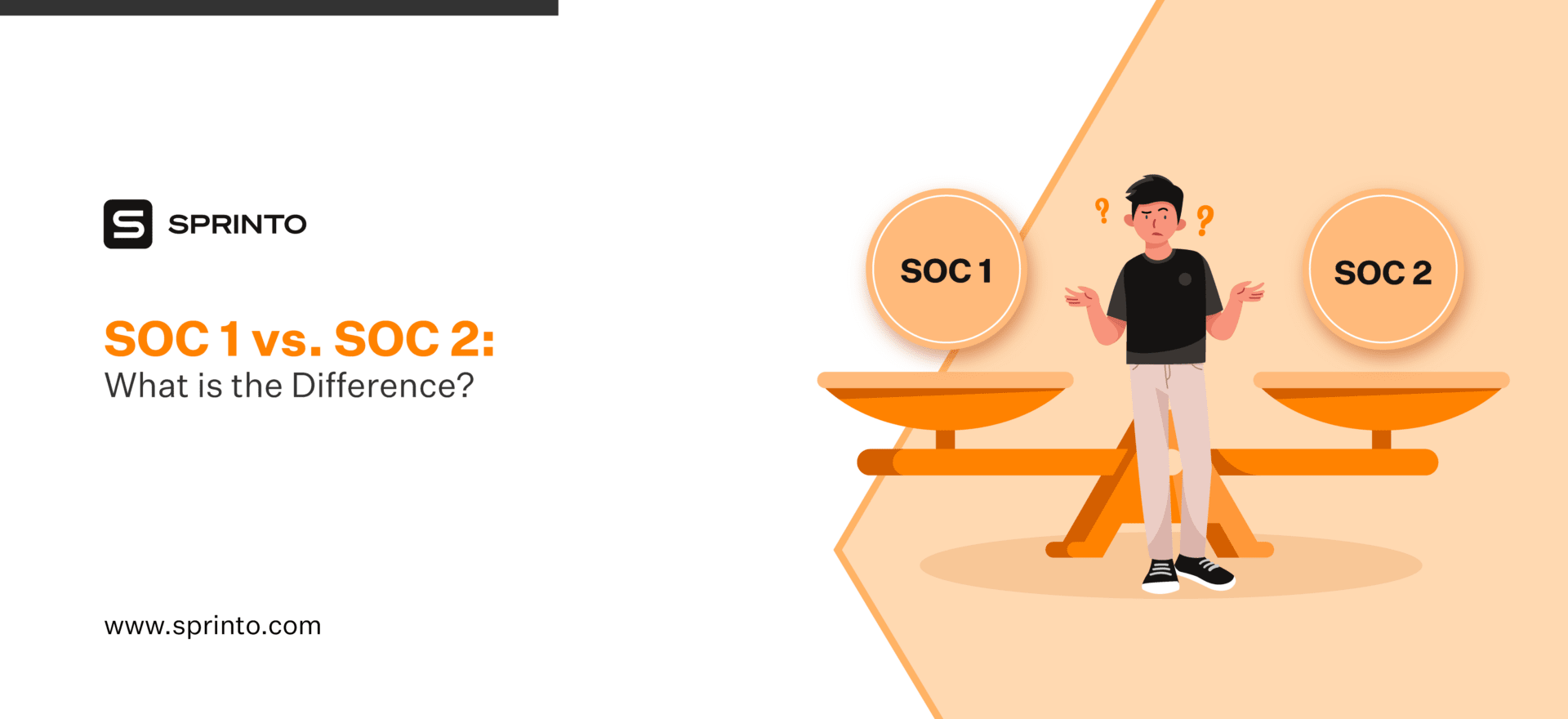Information security and compliance aren’t anymore just nice-to-have features.
Thanks to the proliferation of cloud-hosted applications, SaaS businesses must now make additional efforts to inspire confidence and trust in how they manage and establish data security. SOC compliance, in this regard, makes for a nifty and industry-approved way to win customers’ trust. But which of the SOC suite of services is applicable to you?
In this article, we will dwell on two popular SOC suites of services – SOC 1 vs SOC 2, and detail the difference between SOC 1 and SOC 2 to help you understand which of the two makes a better fit for your organization and why.
What is the difference between SOC 1 and SOC 2 Report?

The primary difference between an SOC 1 and SOC 2 report is in the scope: While a SOC 1 report primarily focuses on financial controls, SOC 2 reports are a detailed assessment of an organization’s information security, availability, security, processing integrity, confidentiality, and privacy.
While SOC 2 identifies and tests control that meets the requirements, SOC 1 tests control that adheres to the identified control objectives.
Here are the detailed differences between SOC 1 vs SOC 2:
SOC 1 Report:
A SOC 1 Type 2 report evaluates both the design and operating effectiveness of your internal controls over financial reporting (ICFR) over a defined period. It provides assurance to your customers that your organization has consistently maintained financial reporting controls that meet high standards of reliability and accuracy.
Unlike a Type 1 report, which only assesses the design of controls at a single point in time, a SOC 1 Type 2 report validates whether those controls operate effectively over time. This makes it the preferred option for organizations whose operations directly impact their customers’ financial statements.
SOC 1 Type 2 is particularly relevant for SaaS companies in financial services such as those offering billing platforms, payroll systems, or claims processing solutions, where bookkeeping practices directly influence a client’s financial reporting. If your systems touch another organization’s books, this is the report that demonstrates your credibility.
SOC 1 audits follow the SSAE 18 standard, specifically AT-C Section 320, and require your business to define and test key control objectives. These audits are not just about passing a checklist—they’re about showing consistent adherence to financial control processes over time.
In essence, a SOC 1 Type 2 report shows how well you keep your books when your books affect someone else’s.
SOC 1 objectives are based on:
- Business Processes (for instance, controls around processing customer data)
- Information Technology Processes (for instance, controls around protecting customer data)
SOC 1 reports, therefore, are specifically intended for the customers of SaaS firms and the external auditors that audit the customers’ financial statements. The report gives a detailed overview of the organization’s controls on the customer’s financials.
SOC 2 Report:
The SOC 2 report is known as a detailed evaluation of your organization’s control environment against the Trust Services Criteria. It is a detailed description of your SOC 2 audit. It is an evaluation by an independent certified auditor of whether your business provides a secure, available, confidential, and private solution to your customers. The auditor releases the report after examining your organization’s control over one or more of the Trust Services Criteria (that you have chosen). The five Trust Services Criteria (TSC) are Security (mandatory), Availability, Confidentiality, Processing Integrity and Privacy.
The SOC 2 report contains the auditor’s detailed opinion on your internal controls’ design and operating effectiveness. It is, in essence, a testimony to the strength of your infosec practices. It is meant to enable the report users (your customers and customers’ customers) to assess and address the risks that arise from their relationship with your organization. The SOC 2 audit is based on the guidelines of SSAE 18 Section AT-C Section 105 and Section AT-C 205.
SOC 2 compliance is good for data centers, SaaS vendors, IT managed services, and other cloud-computing firms. Cloud-hosted companies that want to work with large customers that handle sensitive data should also consider getting SOC 2 compliant.
Here is the SOC 2 Type 2 report structure for your reference:

Also, find out what SOC 2 report includes with examples

What are SOC Controls/Criteria?
SOC Controls are the processes, policies and systems you put in place to prevent and detect lapses in meeting the SOC compliance requirements. For instance, if your organization is looking to get SOC 2 compliant, the organization controls must be designed and implemented based on the applicable TSCs for your organization.
You must have SOC controls in place as per TSCs to prevent any gap in your SOC report.
Difference between a Type I and a Type II in a SOC report?
SOC reports are of two types – Type 1 and Type 2. The difference? A Type I report evaluates whether controls are suitably designed at a specific point in time, while a Type II report assesses whether those controls are not only suitably designed but also operating effectively over a period of time, typically 3 to 6 months.
In other words, Type I is a snapshot, whereas Type II is a movie reel that demonstrates consistent performance over time.
This distinction holds for both SOC 1 and SOC 2 reports. While a SOC 2 Type I report is quicker to obtain and ideal as an initial milestone, whereas a SOC 2 Type II offers deeper credibility and often becomes a non-negotiable for enterprise deals and vendor assessments as your company scales.

Find out: How to get SOC 2 Type 2 compliance certification
SOC 1 vs SOC 2 – Which one should you choose for your business
To best understand which of the two – SOC 1 vs SOC 2 is applicable to your business, you must appreciate the key differences. For instance, a SOC 1 audit is relevant if you impact your client’s financial reporting, whereas SOC 2 applies when you’re handling sensitive data but not financial-reporting obligations.
Scope: While both the compliance frameworks attest to the SOC controls used within your organization, the frameworks differ in focus. A SOC 1 audit focuses on the internal control over financial reporting (ICFR) and is suitable if you are hosting or processing financial information that could affect your clients’ financial reporting. A SOC 2 audit focuses on the five TSCs outlined earlier and provides evidence of long-term, ongoing processes that protect customer data.
Auditing Standards: Although both audits are based on SSAE 18, SOC 1 addresses section AT-C 320 while SOC 2 addresses sections AT-C 105 and AT-C 205.
Controls: While SOC 1 tests controls that meet the identified control objectives, SOC 2 identifies and tests controls that meet the criteria.

The choice between SOC 1 and SOC 2, therefore, boils down to your business type and customer requirements.
Organizations that offer billing management platforms, payroll processing software, and financial reporting software must opt for SOC 1 compliance. Businesses that provide host data centers, SaaS providers, Cloud Service Providers, HR Management Services, and Recruitment Platforms, to name a few, must consider the SOC 2 framework.

We understand that it can be pretty daunting for businesses unfamiliar with SOC 1 and SOC 2 audit requirements to find a path in the maze of compliances. Having helped hundreds of companies successfully navigate their compliance journey, Sprinto is at a unique vantage to assist you in yours.
We understand that it can be pretty daunting for businesses unfamiliar with SOC audit requirements to find a path in the maze of compliances. Having helped hundreds of companies successfully navigate their compliance journey, Sprinto is at a unique vantage to assist you in yours.
Kickstart your SOC 2 compliance journey with Sprinto. Book a free demo and learn how Sprinto can make your SOC 2 experience effortless and error-free.
Preparing for SOC2 audit?
Here’s your SOC2 Self-assessment Checklist. Download now!

FAQs
What is the difference between SOC 1 and SOC 2 reports?
SOC 1 reports are specifically focussed on financial controls while SOC 2 reports are focussed on information security and other TSC’s like availability, privacy, confidentiality, and integrity. Both reports fall under the AICPA’s System and Organization Controls (SOC) framework but serve very different purposes.
What is SOC 3?
SOC 3 is a lighter version of SOC 2. It covers the same criteria as SOC 2 but is designed for public distribution. While SOC 2 reports are detailed and confidential (shared only with customers or under NDA), SOC 3 reports are summarized, easy to understand, and can be posted on a company’s website.
How much do SOC 1 and SOC 2 cost?
The cost of getting SOC 1 and SOC 2 compliant varies on many factors, such as the scope, support needed, etc. However, typically using a compliance automation platform to get ready for SOC 1 audit will cost you anywhere from $7000 to $ 20000, and SOC 2 will cost you anywhere from $7000 to $50000.
How long does it take to prepare SOC 1 report?
The amount of time it takes to achieve SOC 1 compliance depends on how well-prepared and resource-rich an Organisation is for the task. It can take between two and three months to complete a SOC 1 Type 1 and a readiness assessment the first time around.
How long does it take to prepare SOC 2 report?
The SOC 2 audit itself typically lasts 5 weeks to 3 months, and preparing for it can take just as much time. The time also depends on elements like the size of your audit and the quantity of the involved controls. However, getting a compliance automation tool such as Sprinto can cut down the time from months to days.
Vishal V
Vishal, Sprinto’s Content Lead, masterfully weaves nuanced narratives and simplifies convoluted compliance topics with seasoned expertise. His perennial curiosity fuels his pursuit of fresh angles in every piece. Off-work, he’s an avid photographer, birder and a music buff, he blends expertise and exploration seamlessly in work and life.
Explore more SOC 2 articles
SOC 2 Compliance Overview
SOC 2 Preparation and Documentation
SOC 2 Audit and
Reporting
SOC 2 Differences and Similarities
SOC 2 Updates & Management
SOC 2 Industry-Specific Applications
research & insights curated to help you earn a seat at the table.









